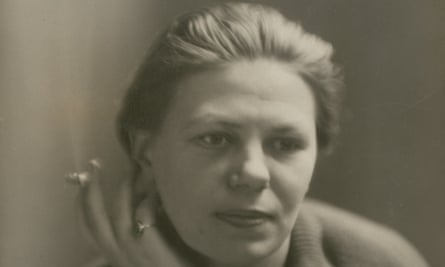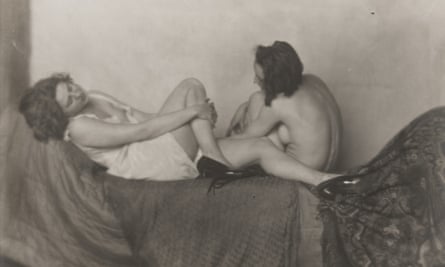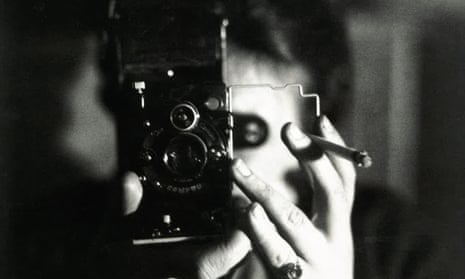When their paths crossed in Paris in the 1920s, Man Ray told Germaine Krull: “Germaine, you and I are the greatest photographers of our time, I in the old sense you in the modern one.”
The work of these two pioneers of modernist photography was included alongside that of Andre Kertesz and Paul Outerbridge in the first French exhibition of modern photography: Salon de l’Escalier, on the Champs Elysée in May 1928. That same year, Krull published a groundbreaking photography book, Métal, in which she helped create a modernist visual poetry through her striking images of steel structures, including the Eiffel Tower, shot from below and filling the frame with its suddenly unfamiliar geometry.
In Martin Parr and Gerry Badger’s authoritative The Photobook Vol.1, it is described as “the finest example of a modernist photobook in the dynamic, cinematic mode” from a photographer “at the forefront of radical modernism”. More than that, Krull was one of the first photographers to treat the photobook as an artistic end in itself, an object as self-contained and expressive as an exhibition.
Since then, Krull’s reputation has faded somewhat, at least in comparison to more celebrated male contemporaries like Man Ray and Moholy-Nagy, but a fascinating exhibition, Germaine Krull (1897–1985): a Photographers Journey, which has just opened at Jeu de Paume in Paris, her adopted city, should go some way to restoring her to her rightful position as a pioneering photographer as well as a radical free spirit.
If 1928 was a pivotal year for Krull, she had already lived a colourful and – even by the bohemian standards of the time – liberated life by then. Born in Wilda-Poznań, East Prussia, in 1897, she had a nomadic childhood, her father, an engineer, uprooting the family to Bosnia, Paris, Slovenia and rural Bavaria, before they eventually settled in 1912 in Munich, where her mother ran a boarding house.

In 1917, having completed a photography studies course, she became part of a group of Munich-based artists and writers that included the political thinker, Kurt Eisner, soon to become prime minister of the Free State of Bavaria. An early series of images of female nudes, Der At, was published in a book of photogravures in 1918, but her fledgling career as a photographer was dramatically interrupted by the assassination of Eisner in early 1919. Krull’s political activism led to her being banned from Munich by the authorities and on a visit to Russia in 1921 she was arrested by the secret police. Accused of being an enemy of Leninism, she was imprisoned on two separate occasions, and, at one point, subjected to a fake execution that left her traumatised for the rest of her life.
She was expelled from Russia in 1922, by which point she was so ill that her hair fell out. When she made it back to Berlin, she found employment as a manager of a photographic studio. There, she worked on several more series of nude studies, including one with a lesbian subtext and another, Friends, that is unashamedly erotic, as well as some striking self portraits.
In 1926, Krull settled in Paris, where she embraced fashion photography, working for a while for the great fabric designer Sonia Delaunay with whom she also photographed more formal portraits and shot an edgily glamorous advertising campaign for the couturier Paul Poiret.
Her artistic breakthrough began in 1928, when she was hired by the nascent VU magazine and the Salon de L’escalier show followed soon afterwards. From 1928 until 1931, the years covered by the new Jeu de Paume exhibition, Krull was at the peak of her creativity, her work appearing frequently in VU and the Surrealist-influenced Belgian magazine, Variétés. She shot the ordinary people of Paris in markets, bistros and on the streets, as well as chronicling the city’s bohemian milieu, befriending and photographing the likes of Colette, Jean Cocteau and André Malraux. Other photobooks followed, including 100 x Paris (1929), Etudes de Nu and Le Valois (both 1930). In 1931, alongside the writer George Simenon she published the first photo-novel, Le Folle d’Itteville.

Krull’s extraordinary life continued apace throughout the 1930s and 1940s, the strength of her leftwing convictions and her restlessness unabated. She joined the Free French in 1941, both as an active member of the resistance and a photographer. After the war, she travelled to South East Asia, where, following in her mother’s footsteps, she became director of the soon-to-be-renowned Oriental Hotel in Bangkok. A sojourn in India followed, during which she lived among an exiled Tibetan community near Dehradun and became a buddhist.
All the while she continued to photograph, chronicling the societies in which she lived – Monte Carlo, Brazil, Southeast Asia and India – in books such as Ballets de Monte Carlo (1937) and Tibetans in India (1968).
From her erotic nudes to her modernist visual studies, and through her myriad careers as a portraitist, fashion photographer and photojournalist, Germaine Krull followed her instincts and kept moving, ever restless, ever curious and relentlessly inventive. If the exhibition at Jeu de Paume only reflects a part of her journey, it is undoubtedly the most creatively fertile part, and, as such, serves as a long overdue celebration of a great artist who lived an independent life to the full.

Comments (…)
Sign in or create your Guardian account to join the discussion